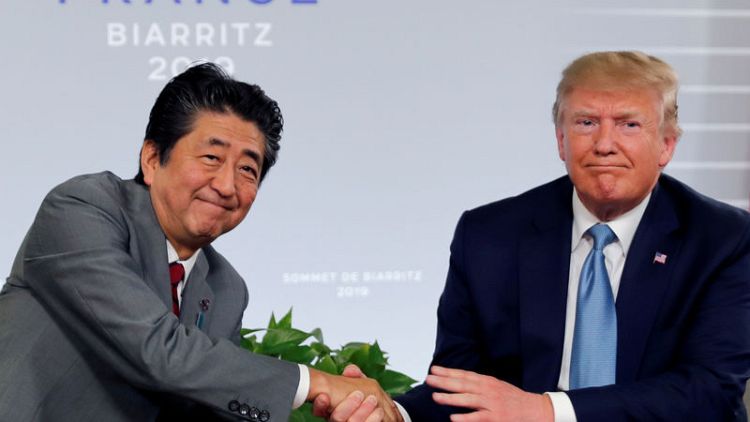By Linda Sieg and Kaori Kaneko
TOKYO (Reuters) - U.S. President Donald Trump and Japanese Prime Minister Shinzo Abe meet in New York later on Wednesday to try to clinch a deal on farm tariffs and digital trade.
Below are some expected key elements and potential sticking points of the pending agreement.
U.S. AUTO TARIFFS
Trump's announcement of an initial deal this month left unanswered whether an agreement would deliver one of the main prizes sought by Japan: a U.S. pledge not to impose national security tariffs of up to 25% on Japanese vehicles and auto parts under Section 232 of U.S. trade law.
People familiar with the talks said on Monday the talks had hit a snag over Japan's demand for such assurances, which it wants in writing.
Foreign Minister Toshimitsu Motegi told reporters in New York after meeting U.S. Trade Representative Robert Lighthizer on Monday that the content "will not be something to worry about", referring to the threatened tariffs.
In a September 2018 joint statement, the two sides agreed to "refrain from taking measures against the spirit of this joint statement during the process of these consultations", words that could be echoed in a fresh deal.
A preliminary deal announced on Aug. 25 included reduced U.S. tariffs on unspecified industrial products but Lighthizer said these did not include autos.
Tokyo has sought removal of a U.S. 2.5% tariff on autos and similar tariffs on auto parts, but a report by the Nikkei business daily said the two sides had failed to agree on a time-line for doing so.
"GOOD CEREMONY"
Motegi told reporters there would be a "good ceremony" when the two leaders meet, but he gave no details.
One scenario, according to a Japanese source familiar with matter who spoke on condition of anonymity, could see Trump and Abe sign a "joint statement" and then officials on both sides would "scrub" a detailed, formal agreement that could be signed in early October.
Jiji news agency said that, based on U.S. estimates, the deal would open Japanese and U.S. markets to the tune of $7 billion each.
BEEF AND PORK
Japan is expected to agree to cut tariffs on imports of U.S. beef and pork to around levels granted to signatories of the multilateral Trans-Pacific Partnership (TPP) pact.
Japan will permit low import tariffs on about 240,000 tons of U.S. beef, with the quota covering about 90% of the amount Japan imports from America, the Nikkei business daily said, adding it would eventually rise to 290,000 tons.
Lower tariffs would help Trump please U.S. farmers ahead of next year's presidential election. Farmers had been disadvantaged after Trump withdrew the United States from TPP in 2017 and have been further hit by the U.S.-China trade war.
It would also let Abe keep a pledge to Japanese producers.
Lighthizer said last month that wheat, dairy products, wine and ethanol would also benefit from the deal.
Washington, meanwhile, will make it easier for Japan to increase U.S.-bound beef exports by scrapping a 200-ton annual low-tariff quota, affording Japan the same beef trade status as Australia, New Zealand and Canada, Japanese media reported.
WINE, RICE
Japan has agreed to phase out tariffs on U.S. wine imports over five to seven years, about the same as the eight-year TPP time-frame, media said, potentially cutting the cost of U.S. wine by about 13% for wine distributors.
However, the amount of U.S. rice that will be allowed to enter Japan tariff-free would be much less than the 70,000 metric tons accepted under the TPP, another Japanese source familiar with the matter said on condition of anonymity.
CURRENCY DEVALUATION
Japanese Finance Minister Taro Aso has said that a currency provision aimed at preventing competitive devaluation would not be included in the final deal. Such a provision would tie Japan's ability to intervene in currency markets should the yen spike and threaten its export-reliant economy.
DIGITAL TRADE
The deal is also expected to include a modernization of digital trade rules, which is expected to reinforce the U.S. model of internet development, prohibiting cross-border taxation of e-commerce and data localization requirements.
(Reporting by Linda Sieg; editing by Darren Schuettler)



